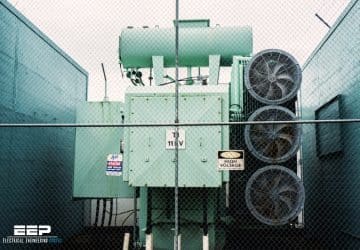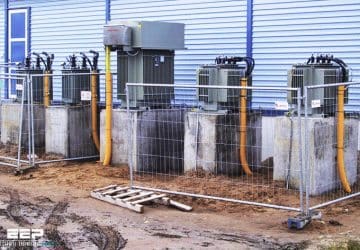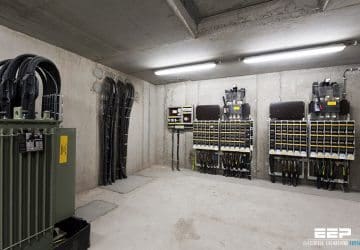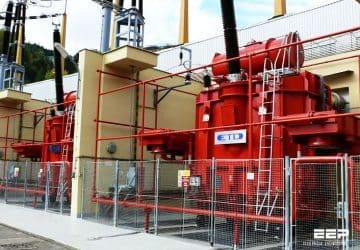Five transformer constructions you’re most likely to see inside buildings
There are several different types of transformer constructions you can see installed in substations inside commercial and other buildings. This article is generally applicable only to transformers of the liquid filled, ventilated dry, or gas filled dry types. Liquid insulated and gas… Read more
Aug 01, 2016 | By Edvard Csanyi

The essentials of AC power transformers for students and beginners
AC power transformers are one of the keys to allowing widespread distribution of electric power as we see it today. Transformers efficiently convert electricity to higher voltage for long distance transmission and back down to low voltages suitable for customer… Read more
Jul 15, 2016 | By Edvard Csanyi

Where and Why Do We Use Grounding Transformer (zig-zag, grounded wye-delta)
Grounding transformers are sometimes used on distribution systems. A grounding transformer provides a source for zero sequence current. Sometimes they are used to convert a 3-wire, ungrounded circuit into a 4-wire, grounded circuit. Figure 1 (see below) shows the two most common grounding transformers. The… Read more
Jun 08, 2016 | By Edvard Csanyi

Do’s and don’ts when measuring insulation resistance of a transformer
This test is performed at or above rated voltage to determine if there are low resistance paths to ground or between winding to winding as a result of winding insulation deterioration. The test measurement values are affected by variables such… Read more
May 18, 2016 | By Edvard Csanyi

Does transformer hum make you nervous? It does me.
Noise is caused by magnetostricition (changes in shape) of the core laminations while the transformer is energized. Transformers emit a low-frequency, tonal noise that people living in their vicinity experience as an irritating “hum” and can hear even against a… Read more
May 04, 2016 | By Edvard Csanyi

How To Reduce Transformer Losses At Design Stage
Design changes to reduce transformer losses, just as in a motor, always involve trade offs. For example, consider varying the cross-sectional area of the transformer core. An increase tends to lower no-load loss while raising the winding loss. An increase… Read more
Apr 29, 2016 | By Edvard Csanyi

How to better understand transformer failures and maintenance necessity
Generally speaking, the transformer requires less care compared to other electrical equipment. But, as I already stated in some of the earlier technical articles, transformer failures can cause a huge problem in power system, since it’s one of the most… Read more
Mar 30, 2016 | By Edvard Csanyi

10 Factors To Consider When Specifying Transformers
There are many factors that influence final specification of a transformer. However, the following ten factors MUST be considered when specifying transformers. Let’s name these ten factors: Kilovoltampere (kVA) Rating Voltage Ratings, Ratio, and Method of Connection (Delta or Wye) Voltage… Read more
Mar 28, 2016 | By Edvard Csanyi

3 Main causes of false differential current in transformer
Certain phenomena can cause a substantial differential current to flow, when there is no fault, and these differential currents are generally sufficient to cause a percentage differential relay to trip. However, in these situations, the differential protection should not disconnect the system… Read more
Mar 21, 2016 | By Edvard Csanyi

Matching transformers for parallel operation
The following rules must be obeyed in order to successfully connect two or more transformers in parallel with each other: The turns ratios of all of the transformers must be nearly equal. The phase angle displacements of all of the… Read more
Mar 16, 2016 | By Edvard Csanyi

Do dry type transformers cost less than oil-filled?
To many industrial and commercial organisations dry type transformers are seen to be advantageous compared with oil filled units. They avoid the perceived fire risk of oil filled transformers and can thus be accommodated inside a building or even on… Read more
Mar 12, 2016 | By Edvard Csanyi

Practical Considerations of LV/MV Private Substations
Private substations can often be considered as terminal type substations, i.e. substations where the MV line ends at the point of installation of the substation itself. They belong to the user and can supply both civil users (schools, hospitals, etc.)… Read more
Mar 04, 2016 | By Edvard Csanyi

Practical Considerations Of Transformer Inrush Current
When a transformer is initially connected to a source of AC voltage, there may be a substantial surge of current through the primary winding called inrush current. This is analogous to the inrush current exhibited by an electric motor that is… Read more
Feb 20, 2016 | By Edvard Csanyi

10 general guidelines for installing power transformers
When your transformer arrives on site, various procedures should be carried out to assure successful operation (installation, testing and various checkings). The successful operation of a transformer is dependent on proper installation as well as on good design and manufacture…. Read more
Feb 08, 2016 | By Edvard Csanyi

5 conditions for perfect parallel operation of single phase transformers
In perfect parallel operation of two or more transformers, current in each transformer would be directly proportional to the transformer capacity, and the arithmetic sum would equal one-half the total current. In practice, this is seldom achieved because of small… Read more
Jan 23, 2016 | By Edvard Csanyi


